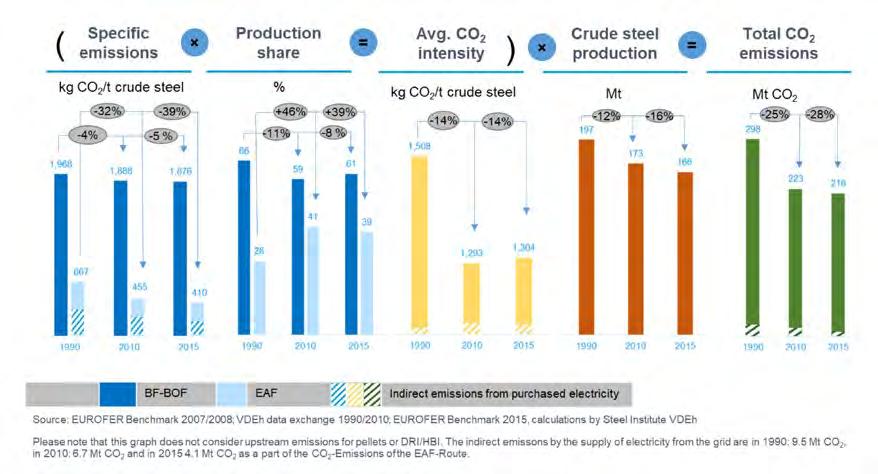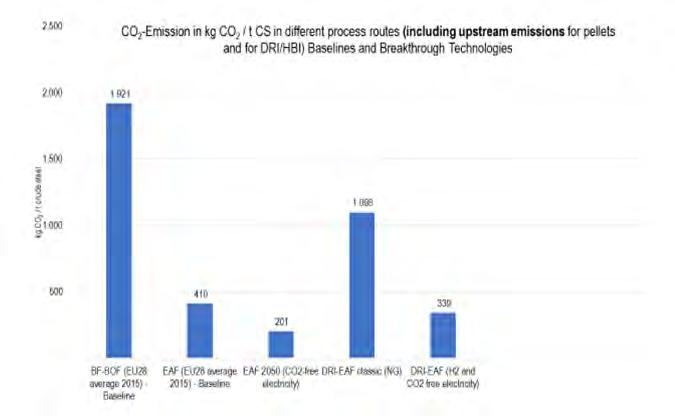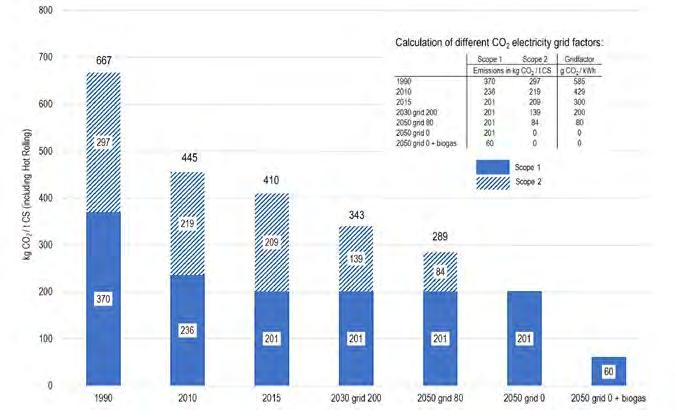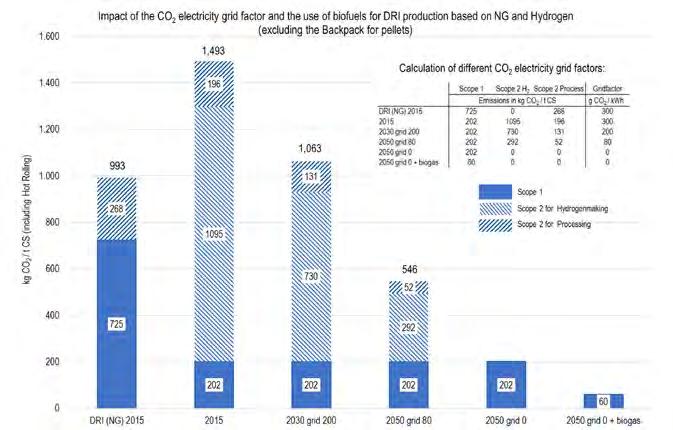
19 minute read
Ways to Reduce CO2 Emissions in Iron and Steel Making in Europe
The key ways to reduce CO2 emissions in iron and steelmaking can be summarised under the general terms “Smart Carbon Usage” (SCU) and “Carbon Direct Avoidance”. SCU covers on the basis of carbon carriers as reductant incremental measures at the conventional blast furnace converter route and the CO2 mitigation measures by applying so-called “end-of-pipe” technologies like CCS (CO2 Capture and Storage) and CCU (Carbon Capture and Usage). CDA covers the scrap based electric arc furnace route and the iron ore based steelmaking route via direct reduction plant and electric arc furnace by the use of natural gas and/or hydrogen as reducing agent, which means the complete avoidance of coal and coke for the reduction of iron ores. The application of CCU at the conventional blast furnace converter route, which means the conversion of process gases into chemical raw materials, as well as the implementation of the direct reduction technology with hydrogen and subsequent smelting of the DRI (Direct Reduced Iron) to steel in an electric arc furnace require an immense amount of hydrogen and CO2-free electric energy.
AUTHOR: Dr.-Ing. Hans Bodo Lüngen, Executive Member of the Managing Board, Steel Institute VDEh, Germany
Advertisement
CONTACT: hans-bodo.luengen@vdeh.de
The council of the European Commission has already in 2011 published a roadmap for attaining a competitive low-carbon economy by 2050. According to this the European industry would have to cut back its CO2 emissions below 1990 levels by 80 to 95 % by the year 2050. This is an enormous challenge for the total industry. The EU steel industry has, for many years, been at the forefront of R&D into breakthrough technologies via a large number of projects. An environmental friendly, innovative and competitive steel industry plays a decisive role in achieving long term climate targets. In this context, EUROFER – the European Steel Association – placed an order to the Steel Institute VDEh to update the steel roadmap of the year 2013 [1], in which the Steel Institute VDEh was also involved. Steel Institute VDEh just took over the pure technical part for this study, which started in March 2018 and ended in March 2019. The main results were presented at the 4th European Steel Technology and Application Days in June 2019 in Düsseldorf [2] .
Figure 1 presents the applied production routes for steelmaking in Europe with its current specific CO2 emissions [3]. In the blast furnace converter route the CO2 emissions of 1880 kg/t crude steel (CS) are generated directly in the production processes coke plant, sinter plant, blast furnace, converter and the subsequent process steps casting and rolling (not shown in the figure). The main CO2 amount in this route comes from the blast furnace. The reduction of iron ores in the blast furnace with
Figure 2: System boundaries to evaluate the CO2 footprint of the EU 28 steel industry [2]

carbon or carbon monoxide (CO) respectively inevitably leads to carbon dioxide (CO2). The chemical used carbon in the blast furnace process will be emitted as CO2 to the atmosphere after energetic conversion/use of the carbon monoxide and carbon dioxide containing blast furnace gas and by processing of the carbon containing hot metal. In the integrated blast furnace converter route the blast furnace produces a liquid hot metal with a temperature of 1.500°C from which the main amount of the iron ore gangue materials are separated via a liquid slag. An operation of a blast furnace without coke is not possible due to physical reasons. The main physical tasks of the coke are to guarantee the gas permeability of the furnace in the shaft area, where the iron ores are softening and melting (cohesive zone), the drainage of hot metal and slag in the hearth and to build a supporting grid for the overlying burden layers above the cohesive zone.
The process gases of the coke plant, the blast furnace and the converter steel shop are amongst others used for the production of electric energy. By this the CO content in the gases are oxidized by burning into CO2 and emitted with power plant waste gas to the atmosphere. This route is completely supplying its need for electricity by own production.
In the scrap based electric steelmaking route just a part of the CO2 emissions is generated by the processes itself. The main part of the CO2 emissions comes from the CO2 load of the external purchased electric energy for the processes, as the electric arc furnace route does not produce process gases which are energetic applicable for electricity production. The CO2 emission of this route is in the range of 410 kg/t CS at a
Figure 3: Results of the evaluation of CO2 emissions of the European steel industry in 1990, 2010 and 2015 [2] CO2 load factor of 330 g/kWh. Using iron ore reduction technology as a pre-step for steelmaking, hydrogen is the only alternative reducing agent to carbon monoxide. Since the beginning of the 1970ies hydrogen rich natural gas is used as reducing agent for the reduction of iron ores in industrial applied direct reduction technology. Sponge iron/DRI is produced for example in a shaft furnace process. In this process most of the oxygen is removed from the iron ores to produce DRI but the DRI is solid and still contains all the gangue materials of the iron ores. The processing of the DRI to crude steel with smelting and slag metallurgy occurs in an electric arc furnace. The CO2 emissions of this route are in the range of 990 kg/t CS.

The specific and total CO2 emissions for the EU28 steel industry were calculated for 1990 to get the correct number for the base year as well as for 2010 from the study in 2013 [1] and for 2015 for this follow-up study to highlight the CO2 mitigation for the last two and a half decades.
The system boundaries for the calculation of the CO2 emissions of the steel industry in Europe were agreed upon in a way, that the CO2 emissions of the process steps are in the balance as direct emissions (Scope I), Figure 2. The CO2 emissions generated by the energetic use of the process gases of the integrated route, which supplies electric power, are already in the balance of the individual process steps. Regarding the scrap and also the DRI based electric arc furnace route, which does not produce any energetic usable process gases for power production, the CO2 load of the external supplied electric power is going as indirect emissions into the balance (Scope II). For comparison the CO2 load of purchased materials, like iron ore pellets or DRI (Direct Reduced Iron) were partly for some scenarios considered in the balance (Scope III).
Process gases generated along the value chain are used to produce electricity and heat, rendering sufficient power to satisfy the electricity demand in an integrated plant (the self-sufficiency assumption). So, no credits could be considered for this in the CO2 balance. The aspect of granulated blast furnace slag which leads by its use in cement production to CO2 mitigation was not investi-
gated further in this study as a CO2 credit to avoid double counting.
The evaluation of 1990 and 2015 shows a drop of the total CO2 emissions of the steel industry by 28 % from 298 to 216 million t as shown in the green bars on the right site of the Figure 3. In the same period the crude steel production in the EU decreased from 197 million t to 166 million t in 2015 by 16 %, shown with the red bars under crude steel production. The specific CO2 emission per t crude steel decreased by 14 % from 1.5 to 1.3 t, shown with the yellow bars below Avg. CO2 intensity. The share of electric steelmaking at total steelmaking increased from 28 % to 39 % in 2015, bars under production share. The CO2 load of the externally purchased electricity for electric steelmaking dropped in the same time from 585 g CO2/kWh to 300 g CO2/kWh. Finally, the production decrease in Europe contributed to almost by 50 % of the total CO2 mitigation of 28 % absolute.
Options to reach the CO2 Mitigation targets by 2050
The key options for CO2 mitigations of the EU steel industry can be summarised in the two pathways: Smart carbon usage (SCU) and carbon direct avoidance (CDA), Figure 4.
SCU includes under process integration with reduced use of carbon the incremental measures of the conventional blast furnace converter route to reduce CO2 emissions. This may also include so-called end-of-pipe technologies like CCS (CO2 Capture and Storage) and CCU (Carbon Capture and Usage).
Figure 4: Projects and initiatives for mitigation of CO2 emissions in the EU steel industry

The group of carbon direct avoidance (CDA) includes the process routes scrap based EAF with CO2-free electricity and the DRI-EAF route based on natural gas and hydrogen and CO2-free electricity. The change from integrated carbon based blast furnace/converter route to hydrogen DRI/EAF route would result in no further need for coke and sinter, but instead the need for hydrogen and pellets.
One main assumption for the study is that there will be no carbon leakage for the steel industry in Europe. This means that the whole agglomerated iron ore burden materials for the processes should be produced within Europe and accounted as direct emissions.
Smart Carbon Usage (SCU)
The incremental measures at the existing iron and steel works have CO2 mitigation effects, but do not lead to massive CO2 mitigation without the application of CCS and CCU.
Projects combined with CCU are Carbon2Chem and Steelanol, the project combined with CCS is the HIsarna smelting reduction process, Figure 5 [4] . In this process, fine ores and non-coking coal and oxygen are used to produce liquid hot metal. The HIsarna-BOF route does not need any cokemaking and ore agglomeration steps.
The high CO2 concentration of the off-gas will be beneficial for combining HIsarna with CCS.
Steelanol is converting the CO and H2 in the blast furnace gas by using microbes into ethanol. In this way carbon is bound into chemicals (CCU) which would otherwise be incinerated to CO2. What is left after Steelanol is a CO2-rich stream which can directly be used in the IGAR technology (which stands for Injection de Gaz Réformé) to reform natural gas in a plasma torch to obtain a hot reducing gas composed of CO and H2, Figure 6 [5] .
This reducing gas is injected through tuyeres into the blast furnace. Carbon lean electricity will be used for plasma gas processing. As the process is running on oxygen only (no hot air), high injections rates of solid carbon containing waste materials (as solid biomass and plastic) in combination with the hot reducing gas are minimising the coke rate of the blast furnace.
As all the carbon is at maximum recycled or converted into chemicals, this combination of technologies is illustrating how also carbon and CO2 can be reused in a circular way.
The Carbon2Chem initiative of Thyssenkrupp aims to use process gases of

the integrated iron and steelworks, like coke oven gas, blast furnace top gas and converter gas, as a starting material for chemical products avoiding the CO2emissions when these gases would be burnt in a power plant for the generation of electricity. Thus, the project is an essential contribution to climate protection as well as energy transition. On the other hand, the amount of the gases used for the production of chemical products are no longer available for the production of electricity needed by the integrated works. The missing electric energy then needs to be supplied from external sources which must CO2 free. The Carbon2Chem concept needs hydrogen from green energy sources for the chemical processes involved in ammonia and methanol production.
Carbon Direct Avoidance (CDA)
The focus of Carbon Direct Avoidance will be set on the process route with direct reduction of iron ores and the use of the DRI in an electric arc furnace, Figure 8. For the direct reduction of iron ores with hydrogen shaft furnace processes will be used.
In 2018 around 110 DRI shaft furnace plants (Midrex, HyL/Energiron) were operated worldwide with a production volume of 79.4 Mio. t DRI which is 79 % of the worldwide DRI production [7]. Maximum annual capacity of a single module is 2.5 million t DRI. They are still mostly located and operated where low cost natural gas is available. Only one plant is operated in Europe at ArcelorMittal Hamburg [7] . In these furnaces the iron ores, mostly in the form of pellets, are reduced in the “dry” stage by CO and H2 from cracking of natural gas. No liquid phases occur, no slag metallurgy is done and
Figure 6: IGAR Steelanol process combination [5]

no coke is needed. The produced DRI contains all the gangue materials from the iron ores, so that the slag metallurgy must be done in the subsequent electric arc furnace during crude steel production. The reducing gas fed to the industrial direct reduction shaft furnaces already contains 60 to 80 % hydrogen. The idea of CDA is to inject up to 100 % hydrogen.
Figure 9 sums up the projects for CO2 mitigation in Europe. For the CCU projects IGAR/Steelanol and Carbon2Chem in the smart carbon usage pathway, the CO2 emissions released to the atmosphere may come down to levels below 600 kg CO2/t crude steel [2]. But one has to keep in mind that carbon is still in the CCU products.
The HIsarna process with CCS in combination with basic oxygen steelmaking converter may come to CO2 emissions of also less than 600 kg CO2/t crude steel [2] . All other projects are in the pathway carbon direct avoidance. The hydrogen based DRI production combined with electric arc furnace is developed at ArcelorMittal, Dillinger, Salzgitter and Thyssenkrupp in Germany, at SSAB/ LKAB/Vattenfall in Sweden and at voestalpine in Austria. voestalpine is also working on a project on iron ore reduction with hydrogen in a plasma smelting reduction reactor in laboratory scale. The CDA processes may reach CO2 emissions of below 340 kg CO2/t crude steel.
All projects mentioned here need huge amounts of CO2-free hydrogen and CO2-free electric energy.


Comparison of the CO2 mitigation options (CCU/CCS not included)
Figure 10 summarises the results for CO2 mitigation for the different alternative routes in comparison with the blast furnace converter and the scrap based EAF routes, whereby the options with the end-of-pipe-technologies CCU and CCS where not considered.
The results include upstream CO2 emissions for pellets charged to the blast furnace and to the DRI shaft. For all routes the CO2 emissions of the downstream plants continuous casting and rolling are considered.
The BF-BOF route has a CO2 emission of 1921 kg/t crude steel. The scrap based EAF baseline route with a CO2 load of electricity in 2015 of 300 g/kWh has a CO2 emission of 410 kg/t crude steel. The assumption of the use of CO2 free electricity reduces the baseline steel scrap EAF route to just only 201 kg CO2/t crude steel. One could not conclude from this, that a solution of the CO2-mitigation challenge could be simply the change over from the blast furnace converter route to the scrap based EAF
route. It has to be kept in mind, that not all steel grades can be produced via the scrap based EAF route. To produce high grade flat steel products virgin iron ores or very clean scraps are needed as iron bearing input materials. The natural gas based DRI-EAF route emits with the current CO2 load of the electricity 1,098 kg CO2/t crude steel. The availability of CO2-free electricity is also the prerequisite for the DRI/EAF route based on hydrogen for iron ore reduction resulting in CO2 emissions down to 339 kg/t crude steel.
The impact of the CO2 electricity grid factor over the years from 1990 to 2050 on the scrap based EAF route is shown in Figure 11. Massive CO2 emissions reduction of this route is dependent on the CO2 load of the electrical energy. The “International Energy Agency” has forecast for the year 2050 a CO2 grid factor of 80 g/kWh. This leads for the scrap based EAF route to a CO2 mitigation down to 289 kg/t crude steel which is minus 57 % in 2050 compared to 1990 level. If the supplied energy is based on CO2 neutral fuels and CO2-free electricity, then the CO2 emissions could be decreased to 60 kg/t crude steel which is a CO2 mitigation of 91 % compared to 1990 levels. The remaining CO2 emissions are coming inevitably from electrode consumption and from the charged additions and alloying elements. The same effect of the CO2 intensity of electricity is to be seen for the natural gas and hydrogen based DRIEAF route, Figure 12. At a grid factor of 80 g CO2/kWh the CO2 emissions may come down in 2050 by 73 % to 546 kg CO2/t crude steel compared to the BF-BOF baseline in 1990 which was 1968 kg CO2/t crude steel (see Figure 3). The hydrogen based DRI-EAF route is on the same CO2 intensity level of 202 kg/t crude steel as the scrap based
Figure 8: Production of “green steel” with hydrogen as reductant

Figure 9: Projects of the EU steel industry on CO2 mitigation

EAF rout in the case of zero CO2 load of electricity. A possible backpack for the charged pellets to the DRI plant was not considered.
When also using CO2 neutral fuels for upstream and downstream processes, the resulting CO2 intensity is also only 60 kg/t crude steel for the hydrogen based DRI/EAF route. The CO2 mitigation achieved compared to the 1990 level of the blast furnace converter route is 97 %. To achieve this goal also pellets need to be produced CO2-free.
CO2 emissions of the EU 28 steel industry in 2050 for reaching the set targets
What does it mean under the targets given by the EU of CO2 mitigation levels of 80 or 95 % in 2050 compared to 1990 levels for maximum allowable CO2 emissions, if the total crude steel production of the EU 28 steel industry remains on the 2015 level of 166 million t?
As to be seen in Figure 13, the total emissions need to be reduced for the EU steel industry from 298 million t in


Figure 12: Direct and indirect emissions of the DRI natural gas and DRI hydrogen based EAF route [2]

1990 to 60 million t in 2050 for the 80 % scenario and to 15 million t in the 95 % scenario. This means specific CO2 emissions of 361 kg and 90 kg/t crude steel respectively. The 95 % mitigation target is achievable by the availability of huge amounts of CO2-free electricity and CO2-free produced hydrogen, CO2-neutral carbon based fuels (biomass) and/or the application of CCU and CCS for carbon based iron ore reduction routes.The demand for green electricity for the EU steel industry only could raise in 2050 to a level of approximately 450 to 500 TWh/a.
Conclusions
The new ways for reaching massive CO2 mitigation in steel production can be subdivided in the sectors “Smart Carbon Usage” (SCU) with processes based on carbon for steelmaking and “Carbon Direct Avoidance” (CDA), which use electricity and hydrogen for steelmaking. For all processes and scenari-
References
[1] P. DAHLMANN, J-T. GHENDA, H.B LÜNGEN, F. SCHULER, N. VOIGT and M. WÖRTLER: Steel’s contribution to a low-carbon Europe (2013). [2] P. DAHLMANN, H.B. LÜNGEN and M. SPRECHER: Steel Roadmap for a Low Carbon Europe 2050 - Technical Assessment of Steelmaking Routes; Presented at METEC and 4th ESTAD on 25 June 2019, Düsseldorf, GERMANY. [3] H.B. LÜNGEN and P. SCHMÖLE: Wege zur Minderung der CO2-Emissionen bei der Eisen- und Stahlherstellung; Fachtagung Kokereitechnik, Dortmund (2019). [4] J. VAN DER STEL, K. MEIJER, CH. ZEILSTRA, T. VAN BOGGELEN and R. DRY: HIsarna smelting reduction - a solution for sustainable hot metal production; in: Reducing the carbon footprint of the steel industry, Zaandam and Petten, NL (2017). [5] C. DE MARÉ: ArcelorMittal Europe Media Day, Paris (2018). [6] M. OLES: Carbon2Chem: Reduce CO2-emissions in a cross industrial network; 4th METEC & ESTAD, 24-28 June 2019, Düsseldorf, GERMANY. [7] 2018 world direct reduction statistics, MIDREX (www.midrex.com). [8] Nachhaltige Stahlproduktion an der Saar: Dillinger und Saarstahl setzen erstmalig auf Wasserstoff im Hochofen zur CO2-Minderung; ROGESA Pressemitteilung vom 24. Mai 2019 [9] Transformation der Stahlindustrie benötigt industriepolitische Unterstützung; STAHL + TECHNIK 2 (2020), Nr. 3, S. 72/77 [10] M. HÖLLING, M. WENG, S. GELLERT: Bewertung der Herstellung von Eisenschwamm unter Verwendung von Wasserstoff; stahl und eisen 137 (2017), Nr. 6, S. 47/53 [11] Wasserstoff-Stahlproduktion in Hamburg; STAHL + TECHNIK 1 (2019), Nr. 10, S. 21 [12] V. HILLE: SALCOS – Sustainable, stepwise and flexible decarbonisation based on proven technology; Proceedings of METEC & 4th ESTAD, 24-28 June 2019, Düsseldorf, GERMANY [13] Hybrit JV planning to begin building demo plant for fossil-free steel in 2023; 02 June 2020 (https://www.greencarcongress.com) [14] thyssenkrupp: Unterwegs in eine Zukunft ohne CO2 (https://www.thyssenkrupp-steel.com) [15] K. KNITTERSCHEID: Schluss mit Koksen, Handelsblatt, 21.01.2019 [16] Th. BUERGLER: Technology development hydrogen steelmaking; Proceedings of METEC & 4th ESTAD, 24-28 June 2019, Düsseldorf, GERMANY. Figure 13: Maximum allowable CO2-emissions in 2050 to reach the 80 % and 90 % mitigation target

os to reach the 95 % CO2 mitigation target by 2050 compared to 1990 level an extreme huge amount of green electric energy, green hydrogen and biomass is necessary and for the carbon based routes CCS and/or CCU technologies as well. The new ways for low-carbon steelmaking require tremendous financial resources for “Capex” and “Opex” for new plants and a lot of time.
Since more than 50 years!


CRANEFRIGOR™ – AC-unit for severe duty conditions works.

FrigorTec GmbH • info@frigortec.de • www.frigortec.com








